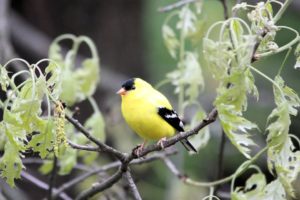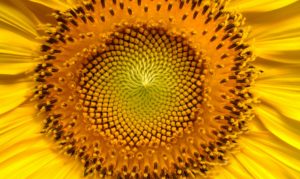 As summer blooms fade, it’s tempting to tidy up.
As summer blooms fade, it’s tempting to tidy up.
Resist!
Cutting off flower heads is like emptying the pantry before Thanksgiving. Birds depend on seeds and berries to survive the fall and winter.
Grasses provide birds with food as well as cover from blustery winds. The leaves in your garden have been converted into winter homes for many insects including butterflies in various developmental stages.
So, wait to prune and rake your flower beds till spring. Let the birds and other wildlife enjoy your garden while you stay inside.
Here are some native plants favored by birds for their seeds or berries:
Asteraceae, probably the largest plant family, are a major food source for birds:
Asters (same scientific name)

Black-eyed Susan, Rudbeckia hirta
Blanket flower, Gaillardia pulchella
Coreopsis (same scientific name)
Daisy, Bellis perennis
False or oxeye sunflower, Heliopsis helianthoides
Gayfeather, Liatris
Goldenrod, Solidago
Green and gold, Chrysogonum
New York ironweed, Vernonia noveboracensis
Purple cone flower, Echinacea purpurea
Spotted Joe Pye weed, Eutrochium maculatum

Sunflower, Helianthus

Other favorites perennials, shrubs and trees food sources for birds:
American beautyberry, Callicarpa Americana (bush)
American cranberry bush viburnum, Viburnum trilobum
American holly, Ilex opaca (tree)

Arborvitae, Thuja occidentalis (tree)
Black chokeberry, Aronia melanocarpa (bush)
Dogwood tree, Cornus florida
Eastern red cedar, Juniperus virginiana (tree)
Red chokeberry, Aronia arbutifolia (bush)
Serviceberry, Amelanchier, (shrub or small tree)
Sumac, Rhus (bush or small tree)
Winterberry, Ilex verticillate (bush)
Grasses:
Little bluestem, Schizachyrium scoparium
Switchgrass, Panicum virgatum
Northern sea oats, Chasmanthium latifolium
To see other grasses native to Maryland’s Piedmont region, go to
https://www.nps.gov/plants/pubs/nativesMD/piedmont/piedmont-grass.htm
A website from the USFWS BayScapes Conservation Landscaping Program
Don’t Prune Shrubs or Trees in the Fall Either!
 Bushes and trees should not be pruned in the fall unless a branch is diseased or dead.
Bushes and trees should not be pruned in the fall unless a branch is diseased or dead.
Trimming stimulates growth. If you prune between August and October, the new growth will not have time to harden off and survive the winter.
The University of Maryland Extension provides the complete scoop on pruning:
https://extension.umd.edu/sites/extension.umd.edu/files/_images/programs/hgic/Publications/HG84_Pruning%20ornamental%20plants.pdf
Pining to prune?

There are some plants that should be pruned. Deadhead irises; lilies, lilium; bee-balm, Monarda didyma; bellflower, Campanula; and  pincushion flower, Scabiosa. Laura
pincushion flower, Scabiosa. Laura
